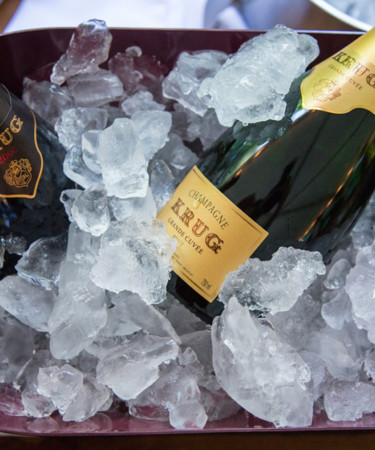Few Champagne producers have a higher reputation than Krug, one of the region’s top Champagne houses. This isn’t the kind of Champagne served as part of a club’s bottle service or available for sale at an everyday liquor store. It’s serious juice, sought after by collectors and connoisseurs alike. Even sommeliers and oenophiles who swear by grower Champagne make an exception for Krug.
If you don’t know Krug, you should. Here are 13 facts about this heralded house to get you started.
Krug was founded in 1843.
The house was founded in the city of Reims by German-born Joseph Krug, who worked as an accountant and bookkeeper for Champagne Jacquesson before founding Krug.
Thanks to one woman, Krug continued during World War I.
During the First World War, Joseph Krug II, then managing the house, was taken prisoner. His wife Jeanne managed the estate in his stead.
Krug has remained in the family for six generations.
Though Krug was purchased by LVMH in 1999, Olivier Krug is still the house’s director.
Krug is known as the master of blended Champagne.
Krug separates all of its base wines according to vineyard plots, tastes them individually, and blends them later. All wine is vinified in wooden casks and undergoes malolactic fermentation, which is why Krug Champagnes are known for being rich, complex, and long-aging. If a plot’s juice does not meet the house’s standard, it will be sold to another producer as bulk wine.
Krug’s top bottling, or prestige cuvée, is ‘Grande Cuvée.’
Unlike most Champagne houses, Krug’s “Grande Cuvée” comprises the majority of its production. It is made from all three primary Champagne varieties: Pinot Noir, Chardonnay, and Pinot Meunier.
Prior to 1978, ‘Grande Cuvée’ was called ‘Private Cuvée.’
The new name aligned with the original Krug Champagne, then called Champagne No.1 Krug Grande Cuvée. Krug also adjusted the bottle shape of its wines in 1978, swapping standard Champagne bottles for the iconic narrow-necked bottles it still uses today.
Krug ‘Grande Cuvée’ is not a vintage Champagne.
The vast majority of prestige cuvées from houses are vintage Champagnes, which are generally thought to be more prestigious than non-vintage Champagne. However, the “Grande Cuvée” is composed of more than 120 different base wines from 10 different vintages in an attempt to showcase Krug’s reserve wines through a multi-vintage blend.
There’s a secret code that will tell you what exactly goes into each bottle of Grande Cuvée.
Since 2011, there has been a six-digit code on the back label of every bottle of Krug “Grande Cuvée.” Enter this Krug ID on Krug’s website and discover which vintages, grapes, and vineyard plots were used to make that specific blend.
Other than the ‘Grande Cuvée,’ the Krug Rosé is the house’s only non-vintage wine.
The rosé was originally created as an experiment in the 1970s by brothers Henri and Rémi Krug. It gets its color from skin-fermented Pinot Noir.
All vintage Krug Champagnes must be aged for at least 10 years.
That’s seven years more than the legal requirement for both the standard and single-vineyard vintage Champagnes.
It’s a little easier (but still expensive!) to find older vintage Krug.
Krug saves a portion of every vintage created to release later as a “Krug Collection” Champagne. The most recent “Krug Collection” Champagne to be released is the 1990 vintage.
Krug makes two lauded single-vineyard Champagnes: a blanc de blancs and a blanc de noirs.
The “Clos du Mesnil” Blanc de Blancs, sourced from a walled vineyard in the center of Le Mesnil-sur-Oger, was first launched with the 1979 vintage. The “Clos d’Ambonnay” Blanc de Noirs was launched in the mid-aughts with the 1995 vintage.
While there’s no such thing as inexpensive Krug, one cuvée was especially expensive upon first release.
Many were shocked when the Krug “Clos d’Ambonnay” 1995 was launched with a suggested retail price between $3,000 and $3,500 per bottle. Now you can find it for a relative steal: just $2,000 per bottle, if you’re lucky.




